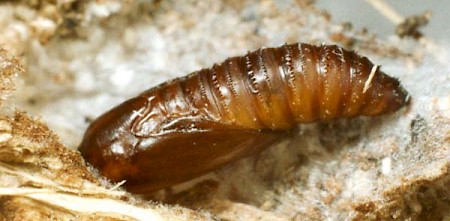Endothenia marginana

49.188 BF1099
Endothenia marginana
(Haworth, 1811)
Wingspan 11-16 mm.
The males of this species have noticeably whitish hindwings which help distinguish it from similar species, but the females have darker hindwings and are more difficult. Adults of this, and several similar Endothenia species, require dissection of the genitalia for accurate identification.
The adults fly from late May into August, and can be found in a variety of open and wooded habitats.
It is distributed throughout much of the British Isles, being common in some places.
The larvae feed from September to June in the seedheads of betony (Betonica officinalis), teasel (Dipsacus fullonum), hemp-nettles (Galeopsis spp.), louseworts (Pedicularis spp.), Yellow rattle (Rhinanthus) and Ribwort plantain (Plantago lanceolata).
More than one larva may be found in a teasel seedhead cavity, where it may be confused with E. gentianaeana. The two species can be segregated by subtle differences in the larvae (see larval descriptions and photographs).
Larva (Description I.F. Smith)
Foodplant: September to June in seedheads of Dipsacus fullonum , Plantago lanceolata, Betonica officinalis, Galeopsis, Pedicularis and Rhinanthus minor.
Length: Specimen described, 12 mm.
Head: Capsule jet black, but often with a very slight pitchy tint. Mouthparts dark reddish brown.
Prothorax (T1): Front margin translucent colourless. Prothoracic shield black, may be slightly pitchy at edges. Divided by median line concolorous with body. Setae on prothoracic shield have tiny yellowish spot at base.
Thoracic legs: Translucent greyish black.
Body: Slightly shagreened. Slightly translucent yellowish white. Early instars may have pale green tinge. Later instars usually greyer and may have pinkish tinge. Contractile dorsal vessel shows as indistinct dorsal line.
Spiracles: Peritreme dark brown.
Pinacula: Shiny. Slightly greyer than integument.
Setae: Transparent colourless.
Anal segment: Anal comb with two to six stout prongs. Anal plate greyish black. Setae have substantial yellowish spot around base.
Prolegs: Concolorous with abdomen. Crochets reddish brown.
Similar species: The diagnostic features which differentiate E. marginana from E. gentianaeana, which also occurs in the seedhead cavity of Dipsacus fullonum, are highlighted in the description above. Caution should be used with head colour, as later instars of
E. gentianaeana can have very dark pitchy heads that can be mistaken for black, and E.marginana can have a pitchiness on the head that makes it indistinguishable from the darkest E. gentianeana. The most reliable feature is the anal comb on E. marginana, which is absent on E. gentianaeana.
Occasionally a larva (not yet reared) identical in appearance to Blastobasis decolorellais found feeding in the seedhead cavity of Dipsacus fullonum. Like E. gentianaeana, it lacks an anal comb, but its head and prothoracic plate are much lighter brown than on either species of Endothenia, and its pinacula are arranged differently.
Examination hints: The anal comb is often not visible when the larva is viewed from directly above. The larva should be tilted on a small watch glass, or similar, and its posterior viewed end on with a binocular microscope or a X10 lens. The anal flap bearing the comb can sometimes be withdrawn under the anal plate (see middle image of anal plates of E. gentianaeana on this site) and conceal the comb for a time, so do not hurry the examination.
Search hints: Peel back a strip of a teasel seedhead, starting at the top, aided by a penknife. If the pith is discoloured or chewed, or if any frass can be seen, there is likely to be a larva. After examination the larva can be replaced and the seed head bound shut with several twists of cotton thread. Keep outside in netting until April, when it can be brought indoors and watched for emergence.

 UKMoths
UKMoths 






